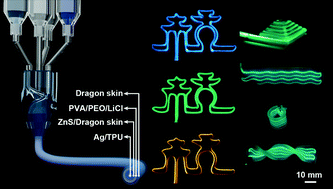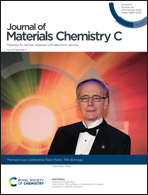Customizable and stretchable fibre-shaped electroluminescent devices via mulitcore-shell direct ink writing†
Abstract
One dimensional (1D) light-emitting fibres emerge as a top candidate for flexible and stretchable displays, enabling the miniaturization of device architectures and integration of different optoelectronic materials and components for new applications in textile- and human body-mounted, biomedical and bio-inspired optoelectronics. While conventional fabrication methods for 1D fibre-shaped devices typically involve multistep layer-by-layer coating processes, which are sophisticated and difficult to be directly integrated with wearable devices, 3D printing offers promise in the rapid integration of disparate functional materials within the printed filaments and facile patterning of 1D device architectures into 2D and 3D arbitrary form factors. Here for the first time, we demonstrate a universal, high throughput, and customizable printing method, known as multicore-shell direct ink writing (DIW) employing digital light processing (DLP)-printed printheads to simultaneously assemble different functional materials into 1D active device motifs. Using a 1D alternating current electroluminescent (ACEL) device as an example, we demonstrate the design and simultaneous printing of different electrodes, phosphors, and encapsulation inks, and the rapid prototyping of 1D ACEL fibres with high stretchability up to ∼450%.

- This article is part of the themed collection: Celebrating Tobin Marks’ 75th Birthday


 Please wait while we load your content...
Please wait while we load your content...